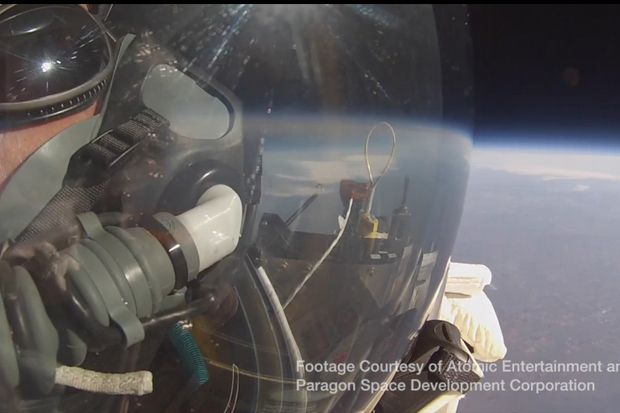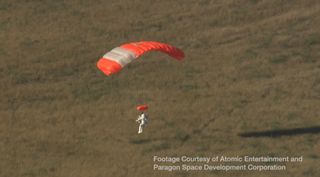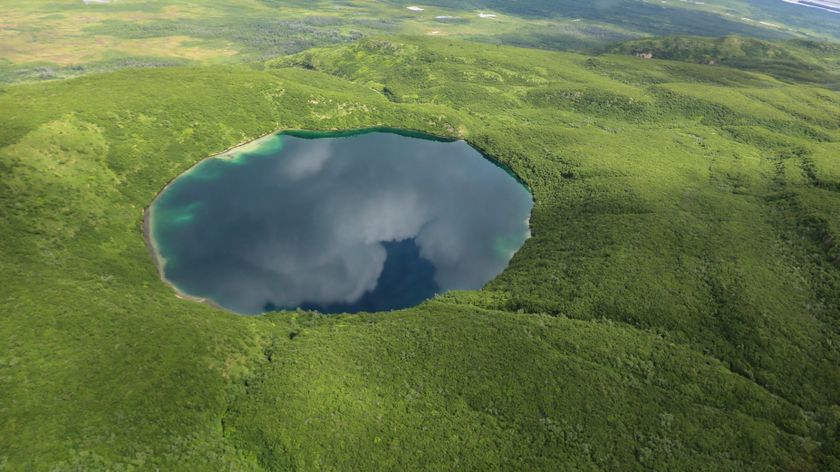'14 Minutes from Earth' Highlights Perils of Death-Defying Skydive

A new documentary chronicles the years-long journey of former Google executive Alan Eustace to complete the highest-altitude skydive in history.
On Oct. 24, 2014, Eustace rode a helium-filled balloon to an altitude of more than 25 miles (40 kilometers) above New Mexico — about 18 miles (29 km) above the typical cruising altitude of commercial airliners. Eustace then pulled a chord that separated him from the balloon and sent him plummeting (safely) back to Earth.
What motivated a 57-year-old tech executive with a wife and two young children to risk his life on such a mission? The new movie "14 Minutes from Earth" gives some insight into Eustace's motivations, but primarily documents the incredible engineering challenge of building a suit that would protect Eustace during his death-defying dive. [Record-Breaking Supersonic Skydive from 'Near-Space' in Photos]
Into the stratosphere
"The idea of being above the Earth's atmosphere … seeing the blackness of space, the curve of the Earth — I mean, that's got to be something that all [Space.com] fans have dreamed about, fantasized about," Eustace told Space.com in an interview. He said that, growing up during the Apollo era, he also harbored fantasies of exploring the space above Earth.
Eustace exudes a mild, agreeable demeanor, but as the movie illustrates, beneath that exterior is an engineer who thrives on being challenged. He also skydives as a hobby, and has completed more than 500 jumps in his life —endeavors that appear to reflect his nerves of steel. [Watch Alan Eustace Leap from 135,000 Feet (Video)]
In 2010, Eustace had the idea to make a suit that would allow human beings to explore high-altitude regions of Earth's atmosphere the way scuba divers explore the depths of the ocean. Just like in the ocean, human exploration is limited by physical barriers, not a lack of courage.
Earth's atmosphere is divided into layers. The troposphere extends from the ground to about 7 miles (11 km) up. The stratosphere, which extends from the top of the troposphere to about 31 miles (50 km) up, is the region that Eustace wants to open up to exploration.
Sign up for the Live Science daily newsletter now
Get the world’s most fascinating discoveries delivered straight to your inbox.
There are many features of the stratosphere that could harm a human: little or no oxygen, low atmospheric pressure and below-freezing temperatures. A person traveling from the ground to the stratosphere and back to the ground in a matter of minutes also has to be protected from the rapid changes in temperature and air pressure, as well as the intense speed and air friction.
To tackle those challenges, Eustace hired Paragon Space Development Corp. to lead a project he dubbed the Stratospheric Explorer (StratEx). The spacesuit manufacturer ILC Dover was brought in as another partner in the project. Once the team was assembled, it took them 18 months to prepare Eustace for his historic jump.

Defying death
The new film paints a beautiful portrayal of the engineering challenges of building an entirely new technology from scratch. During the first test flight from an altitude of 14,000 feet (4,300 meters) — a typical height for recreational skydiving — so many things went wrong, it's a wonder Eustace survived.
The team hadn't fully anticipated Eustace's limited range of motion in the suit, which meant he almost couldn't deploy his parachute, and then couldn't steer it. He survived the fall but landed miles away from the landing range, in the middle of the desert. That would have been fine, except that when he exited the plane, the suit's communications and GPS antenna broke off as he passed through the door, so the team couldn't talk to him and couldn't locate him. Thankfully, a military helicopter was in the area and spotted Eustace's bright-orange parachute from the air.
"[The first jump] served the major role of going, 'Oh my God! We're actually putting a human in a spacesuit — and real [stuff] can go wrong, and we could kill someone," Jane Poynter, one of the founders of Paragon, said in the film.
Another problem that arose during that first flight was that Eustace was spinning and couldn't stop himself. Spinning can cause jumpers to lose consciousness or leave them too disoriented to open their parachute at the right time. In 2012, Austrian skydiver Felix Baumgartner broke the record for the highest-altitude skydive when he leaped from a height of nearly 128,000 feet (39,000 m), or more than 24 miles (38 km). (Eustace added more than a mile to that record, jumping from an altitude of 135,890 feet, or 41,419 m.) Baumgartner also experienced intense, uncontrollable spinning during the first part of his dive, and it nearly killed him. After his first flight, Eustace's team at Paragon added more features to the suit that were designed to stop him from spinning during the fall.
At times, the obstacles of the mission only seemed to grow larger, and the challenges only seemed to grow in number. But Eustace's dedication seemed unwavering. While facing life-threatening situations and massive technical challenges, Eustace continued to exude a positive attitude — even joy.
"Alan definitely has a personality [such that] he liked this because it was so difficult," Jared Leidich, an engineer with Paragon, said in the film. "And the more difficult it got, the cooler he thought it was."
That's not to say Eustace was unaware of the risk he was taking. Toward the end of the film, the risk of the project is thrown into sharp relief during the original launch date for Eustace's record-setting jump. Just before liftoff, a system on the balloon catches fire on the runway, ruining the balloon and aborting the launch. Had the fire started during flight, it could have been fatal.
"It became incredibly real and personal when Alan is saying, 'OK, I've arranged for this airplane; if anything goes wrong, the airplane is going to get [Eustace's wife] Kathy and bring her out,'" Poynter said. "And I'm like, 'Please, God, make it so I don't have to call this plane.'"
Leap of faith
By the time the team was ready for Eustace to make his record-setting leap, the StratEx team had conducted dozens of safety tests and hundreds of dry runs, and put in tens of thousands of engineering hours.
Even though viewers of the film know the outcome of the jump, it is still nerve-racking to watch the final preparation. The film has established that running all the tests in the world doesn't always prepare you for the things that can go wrong during the complete execution of a system.
The film's title, "14 Minutes from Earth," refers to the duration of Eustace's record-setting free fall. A typical skydive from 14,000 feet equates to about 60 seconds of free fall, and about 5 to 7 minutes of coasting after the parachute is deployed. On the way down, he reached a top speed of 822 mph (1,322 km/h), breaking through the sound barrier and creating a sonic boom that could be heard on the ground. Once Eustace hit the ground (after deploying his parachute later than expected), everyone in the control room waited with bated breath until the extraction team called out over the radio, "green extraction," meaning Eustace was unharmed.
"14 Minutes from Earth" is a detailed story about overcoming an incredible engineering challenge in the name of space exploration and the deep human desire to push boundaries. It is available for digital download starting today (Nov. 19) on video on demand services like Amazon, iTunes and others. Video extras, including the uncut video from Eustace's suit camera during his descent, are included on the iTunes version.
Follow Calla Cofield @callacofield. Follow us @Spacedotcom, Facebook and Google+. Original article on Space.com.
Most Popular





